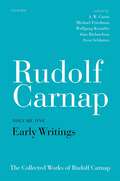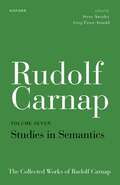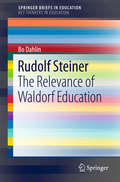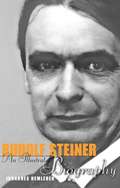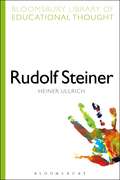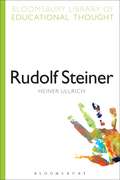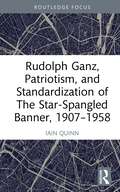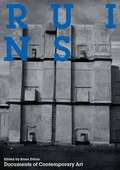- Table View
- List View
Rudolf Carnap: The Collected Works of Rudolf Carnap, Volume 1 (The Collected Works of Rudolf Carnap)
Rudolf Carnap (1891-1970) is generally acknowledged to have been one of the central figures of twentieth-century philosophy. He was the leading philosopher of the Vienna Circle, a group that was central to the international movement known as logical empiricism, which pursued the goal of making philosophy scientific and eliminating metaphysics that went beyond the limits of what humans can coherently comprehend. Carnap was not only well-versed in this area of thought but also contrary ideas; he interacted philosophically with Gottlob Frege, Bertrand Russell, Ludwig Wittgenstein, Edmund Husserl, and Martin Heidegger, and in his formative years he was influenced by the positivists Mach and Ostwald, neo-Kantians such as Cassirer and Natorp, and Husserl's phenomenology. Interest in logical empiricism waned in the decades following Carnap's death but was revived towards the end of the twentieth century; the wave of new scholarship that resulted identified Carnap as far more subtle and interesting than was previously understood. The complete fourteen-volume edition of Carnap's published writings builds upon these more recent interpretations of his philosophy. This first book contains Carnap's early publications up until 1928, none of which have previously been translated from their original German. The introduction and notes place the text in the relevant scientific and historical contexts, in addition to explaining obscure references or outdated notation and terminology. Carnap's neo-Kantian origins are more obvious in these works than in his later writings, and the overall figure which emerges from this volume is a very different Carnap to the caricature that many philosophers will know.
Rudolf Carnap: The Collected Works of Rudolf Carnap, Volume 7 (The Collected Works of Rudolf Carnap)
This volume contains Carnap's Studies in Semantics, a series of three interlocking books: Introduction to Semantics (1942), Formalization of Logic (1942), and Meaning and Necessity (1947). They were extremely influential in their time, especially the third, and shaped the direction of analytic philosophy during the 1950s and 1960s. They constitute the background to a number of celebrated controversies of that period, especially those between Carnap and Quine. Most of the philosophical debates today in philosophical logic and the philosophy of language ultimately had their origins here. This new edition situates these works in their context, both within Carnap's philosophical development and within the philosophical debates they responded to and influenced. The editors' introduction explains how Carnap arrived at the project of semantics in the 1930s and how it developed into these three successive publications, how the three books fit together, and how the project developed and changed in the course of the 1940s. It also describes the reception of the books as they appeared, as well as Carnap's response. The editorial and textual notes give variant readings, Carnap's own marginal notes on these texts in his personal copies, and elucidatory commentary where Carnap's terminology or notation are no longer familiar. This will be an indispensable volume for anyone interested in the origins and preoccupations of present-day analytic philosophy, especially philosophical logic and philosophy of language.
Rudolf Carnap and the Legacy of Logical Empiricism (Vienna Circle Institute Yearbook #16)
by R. CreathThis Institute's Yearbook for the most part, documents its recent activities and provides a forum for the discussion of exact philosophy, logical and empirical investigations, and analysis of language. This volume holds a collection of papers on various aspects of the work of Rudolf Carnap by an international group of distinguished scholars.
Rudolf Carnap, Logical Empiricist: Materials and Perspectives (Synthese Library #73)
by Jaakko HintikkaRudolf Otto: An Introduction to His Philosophical Theology
by Philip C. AlmondAlmond places Otto's theory of religion within the context of his life (1869-1937), looking closely at the significant influences on Otto's thought, among them thinkers as different as Kant and the German Pietists. Elements of Otto's theories are shown to be closely related to the social and intellectual milieu of Germany both before and after World War I. Almond examines Otto's conception of the Holy, of rational and nonrational elements of religion, and compares his views with those of his contemporaries.Originally published 1984.A UNC Press Enduring Edition -- UNC Press Enduring Editions use the latest in digital technology to make available again books from our distinguished backlist that were previously out of print. These editions are published unaltered from the original, and are presented in affordable paperback formats, bringing readers both historical and cultural value.
Rudolf Steiner: The Relevance of Waldorf Education (SpringerBriefs in Education)
by Bo DahlinThis book covers Rudolf Steiner’s biography, presented from an educational point of view and also unfolds the different aspects of Steiner’s educational thought in Waldorf Education. His point of view is unique in that it relates education to a wide horizon of different contexts, such as social, pedagogical, evolutionary and spiritual aspects. His ideas are philosophical (ethical, epistemological, ontological). However, above all, they are based on spiritual understanding of the human being and the world.In many ways, they stand in stark contrast to the views that inform present mainstream educational thought and practice. Nevertheless, there are points where Steiner’s ideas can find a resonance in more recent educational thought. Steiner was in many ways ahead of his time and his educational ideas are still relevant to many present day educational issues and problems.
Rudolf Steiner: An Illustrated Biography
by Johannes HemlebenRudolf Steiner's legacy is remarkable. Around the world, thousands of initiatives have been built up around his inspiration and thought, including Steiner Waldorf schools, special education establishments, medical clinics, biodynamic farms, cultural centres, and much more. At the core of this outer work stands the scientific and spiritual path which Steiner called anthroposophy - a philosophy and method which he expounded and developed throughout his life. Hemleben's concise yet informative biography throws a clear light on Steiner's life and his numerous struggles and achievements. Beginning with Steiner's childhood, Hemleben guides us through his youthful years as a respected Goethean scholar and philosopher in Weimar; his work in the Theosophical Society and the later establishing of the Anthroposophical Society; the development of anthroposophy as a spiritual science; the creation of spiritual initiatives in art, the social sciences, education, medicine, agriculture, religion and architecture; the important Christmas Foundation Conference, and his eventual death in 1925. Hemleben's biography - seen by many as the finest account of Steiner's life and work - includes a chronology, personal tributes, an extensive section for further reading, as well as an index. It is also profusely illustrated, with 69 pictures and photographs.
Rudolf Steiner: Leben Und Lehre (Bloomsbury Library of Educational Thought)
by Heiner UllrichRudolf Steiner is one of the most controversially judged educational reformers of the twentieth century. Although he received little recognition within his field, his educational thought has had a sustained and profound influence, not only in the development of the Waldorf Schools, but also in healing, socially therapeutic work, psychosomatic medicine, biological-dynamic agriculture, corporate organisation, fine arts, and architecture. Heiner Ullrich paints a concise and well-grounded portrait of the creator of the anthroposophic doctrine and Waldorf pedagogy. The text describes a wide arc from the intellectual biography of Rudolf Steiner, across his basic ideas on human development and education, to include discussion of the organisation, curriculum, methods and success of the Waldorf Schools.
Rudolf Steiner (Continuum Library of Educational Thought)
by Heiner Ullrich Richard BaileyRudolf Steiner is one of the most controversially judged educational reformers of the twentieth century. Although he received little recognition within his field, his educational thought has had a sustained and profound influence, not only in the development of the Waldorf Schools, but also in healing, socially therapeutic work, psychosomatic medicine, biological-dynamic agriculture, corporate organisation, fine arts, and architecture. Heiner Ullrich paints a concise and well-grounded portrait of the creator of the anthroposophic doctrine and Waldorf pedagogy. The text describes a wide arc from the intellectual biography of Rudolf Steiner, across his basic ideas on human development and education, to include discussion of the organisation, curriculum, methods and success of the Waldorf Schools.
Rudolf Steiner Speaks to the British: Lectures and Addresses in England and Wales
by Rudolf SteinerAs demonstrated by the contents of this book, Rudolf Steiner was able to speak to the British in a very direct and lively way. He did not need to give a long introductory build-up to his main theme, as was expected of him in Germany for instance, but could refer immediately to esoteric ideas. The intention of this volume is to give a fuller picture of Rudolf Steiner's work in Britain, and his approach to esoteric ideas while on British soil. Although the major lecture series he gave in Britain have been previously published, this book gathers together various lectures, addresses, question-and-answer sessions, minutes of important meetings and articles - a good deal of which has been unavailable in English until now. It also features a complete list of all the lectures and addresses Steiner gave in Britain, making it a valuable reference book for students of Rudolf Steiner's work.
Rudolf Virchow und Gustav Adolph Spiess: Cellular-Pathologie versus Humoral- und Solidarpathologie (Klassische Texte der Wissenschaft)
by Wolfgang U. EckartWolfgang U. Eckart kommentiert aus heutiger Sicht die beiden in die Medizingeschichte eingegangenen Arbeiten "Cellular-Pathologie" (1855) im Archiv für pathologische Anatomie und Physiologie von Rudolf Virchow und „Die Cellular-Pathologie im Gegensatz zur Humoral- und Solidarpathologie“ von Gustav Adolph Spieß, erschienen im gleichen Band des Archivs für pathologische Anatomie und Physiologie.Rudolf Virchow gilt als Gründer der modernen Pathologie. Er entwickelte die Zellularpathologie. Die bahnbrechende Erstveröffentlichung war der Aufsatz "Cellular-Pathologie". Mit dem Werk wird ein neues, mikroskopisch-lokalistisch orientiertes Paradigma in Pathologie und allgemeiner Medizin eingeleitet, das bis heute - wenngleich erweitert - die medizinische Forschung, Diagnostik und Therapie bestimmt. Virchows Gegenspieler Gustav Adolph Spieß publizierte im Anschluss die Polemik „Die Cellular-Pathologie im Gegensatz zur Humoral- und Solidarpathologie“.
Rudolph Ganz, Patriotism, and Standardization of The Star-Spangled Banner, 1907-1958
by Iain QuinnThis book examines the succession of events toward the potential standardization of the music for “The Star-Spangled Banner” from an initial letter to President Roosevelt in 1907 to the 1958 congressional hearings on the National Anthem, and the later work of the Swiss-Born American pianist, Rudolph Ganz. These events took place across five decades when a culture of public patriotism was especially pronounced for immigrant musicians. This book contextualizes the complementary experiences of a leading immigrant musician, Ganz, who successfully navigated the world of public patriotism while pursuing the realization of a standardized version. The materials are discussed through the lens of the performance practice. The legacy of standardization has not previously been examined. The response and actions of an immigrant, Ganz, in a culture of necessary patriotism for foreign-born artists shed important new light on this topic. It demonstrates the challenges, fears, and cultural expectations regarding the standardization of an important patriotic work.
Rudolph Ganz, Patriotism, and Standardization of The Star-Spangled Banner, 1907-1958
by Iain QuinnThis book examines the succession of events toward the potential standardization of the music for “The Star-Spangled Banner” from an initial letter to President Roosevelt in 1907 to the 1958 congressional hearings on the National Anthem, and the later work of the Swiss-Born American pianist, Rudolph Ganz. These events took place across five decades when a culture of public patriotism was especially pronounced for immigrant musicians. This book contextualizes the complementary experiences of a leading immigrant musician, Ganz, who successfully navigated the world of public patriotism while pursuing the realization of a standardized version. The materials are discussed through the lens of the performance practice. The legacy of standardization has not previously been examined. The response and actions of an immigrant, Ganz, in a culture of necessary patriotism for foreign-born artists shed important new light on this topic. It demonstrates the challenges, fears, and cultural expectations regarding the standardization of an important patriotic work.
Ruggiero Boscovich’s Theory of Natural Philosophy: Points, Distances, Determinations (Science Networks. Historical Studies #60)
by Luca GuzzardiDrawing on published works, correspondence and manuscripts, this book offers the most comprehensive reconstruction of Boscovich’s theory within its historical context. It explains the genesis and theoretical as well as epistemological underpinnings in light of the Jesuit tradition to which Boscovich belonged, and contrasts his ideas with those of Newton, Leibniz, and their legacy. Finally, it debates crucial issues in early-modern physical science such as the concept of force, the particle-like structure of matter, the idea of material points and the notion of continuity, and shares novel insights on Boscovich’s alleged influence on later developments in physics. With its attempt to reduce all natural forces to one single law, Boscovich’s Theory of Natural Philosophy, published in 1758, left a lasting impression on scientists and philosophers of every age regarding the fundamental unity of physical phenomena. The theory argues that every pair of material points is subject to one mutual force — and always the same force — which is their propensity to be mutually attracted or repelled, depending on their distance from one another. Furthermore, the action of this unique force is visualized through a famous diagram that fascinated generations of scientists. But his understanding of key terms of the theory — such as the notion of force involved and the very idea of a material point — is only ostensibly similar to our current conceptual framework. Indeed, it needs to be clarified within the plurality of contexts in which it has emerged rather than being considered in view of later developments.The book is recommended for scholars and students interested in the ideas of the early modern period, especially historians and philosophers of science, mathematicians and physicists with an interest in the history of the discipline, and experts on Jesuit science and philosophy.
Ruinen-Ästhetik: Über die Spuren der Zeit im Raum der Gegenwart (Edition Moderne Postmoderne)
by Kevin BückingDie Ästhetik der Ruinen kennzeichnet eine Lust am Paradoxen. Zwischen Natur und Kultur, Erbauung und Zerstörung, Melancholie und Hoffnung, Vergangenheit und Zukunft erscheinen die Ruinen als Spuren der Zeit im Raum der Gegenwart ihrer ästhetischen Begegnung. Kevin Bücking zeigt, inwiefern die Ästhetik der Ruinen und des Ruinösen in einem besonderen Zusammenspiel aus leiblich-sinnlichen Erfahrungen und begrifflichen Reflexionen besteht. In Auseinandersetzung mit unterschiedlichen ästhetischen Medien wie Malerei, Fotografie, Film, Computerspiel und Virtual Reality wird ersichtlich: Die Faszination an Ruinen und Ruinösem ist als ein atmosphärisches Reflexionsgeschehen zu verstehen.
Ruins: Documents Of Contemporary Art (Documents Of Contemporary Art Ser. (PDF)
by Brian DillonThe "ruins" of the modern era are the landmarks of recent art’s turn toward site and situation, history and memory. The abiding interest of artists in ruination and decay has led in particular to the concept of the modern ruin – an ambiguous site of artistic and architectural modernism, personal and collective memories, and the cultural afterlife of eras such as those of state communism and colonialism. Contemporary art’s explorations of the ruin can evoke on the one hand diverse experiences of nostalgia and on the other a ceaselessly renewed encounter with catastrophes of the recent past and apprehensions of the future. For every relic of a harmonious era or utopian dream stands another recalling industrial decline, environmental disaster, and the depredations of war.
Rule Breaking and Political Imagination
by Kenneth A. Shepsle“Imagination may be thought of as a ‘work-around.’ It is a resourceful tactic to ‘undo’ a rule by creating a path around it without necessarily defying it. . . . Transgression, on the other hand, is rule breaking. There is no pretense of reinterpretation; it is defiance pure and simple. Whether imagination or disobedience is the source, constraints need not constrain, ties need not bind.” So writes Kenneth A. Shepsle in his introduction to Rule Breaking and Political Imagination. Institutions are thought to channel the choices of individual actors. But what about when they do not? Throughout history, leaders and politicians have used imagination and transgression to break with constraints upon their agency. Shepsle ranges from ancient Rome to the United States Senate, and from Lyndon B. Johnson to the British House of Commons. He also explores rule breaking in less formal contexts, such as vigilantism in the Old West and the CIA’s actions in the wake of 9/11. Entertaining and thought-provoking, Rule Breaking and Political Imagination will prompt a reassessment of the nature of institutions and remind us of the critical role of political mavericks.
Rule Breaking and Political Imagination
by Kenneth A. Shepsle“Imagination may be thought of as a ‘work-around.’ It is a resourceful tactic to ‘undo’ a rule by creating a path around it without necessarily defying it. . . . Transgression, on the other hand, is rule breaking. There is no pretense of reinterpretation; it is defiance pure and simple. Whether imagination or disobedience is the source, constraints need not constrain, ties need not bind.” So writes Kenneth A. Shepsle in his introduction to Rule Breaking and Political Imagination. Institutions are thought to channel the choices of individual actors. But what about when they do not? Throughout history, leaders and politicians have used imagination and transgression to break with constraints upon their agency. Shepsle ranges from ancient Rome to the United States Senate, and from Lyndon B. Johnson to the British House of Commons. He also explores rule breaking in less formal contexts, such as vigilantism in the Old West and the CIA’s actions in the wake of 9/11. Entertaining and thought-provoking, Rule Breaking and Political Imagination will prompt a reassessment of the nature of institutions and remind us of the critical role of political mavericks.
Rule Breaking and Political Imagination
by Kenneth A. Shepsle“Imagination may be thought of as a ‘work-around.’ It is a resourceful tactic to ‘undo’ a rule by creating a path around it without necessarily defying it. . . . Transgression, on the other hand, is rule breaking. There is no pretense of reinterpretation; it is defiance pure and simple. Whether imagination or disobedience is the source, constraints need not constrain, ties need not bind.” So writes Kenneth A. Shepsle in his introduction to Rule Breaking and Political Imagination. Institutions are thought to channel the choices of individual actors. But what about when they do not? Throughout history, leaders and politicians have used imagination and transgression to break with constraints upon their agency. Shepsle ranges from ancient Rome to the United States Senate, and from Lyndon B. Johnson to the British House of Commons. He also explores rule breaking in less formal contexts, such as vigilantism in the Old West and the CIA’s actions in the wake of 9/11. Entertaining and thought-provoking, Rule Breaking and Political Imagination will prompt a reassessment of the nature of institutions and remind us of the critical role of political mavericks.
Rule Breaking and Political Imagination
by Kenneth A. Shepsle“Imagination may be thought of as a ‘work-around.’ It is a resourceful tactic to ‘undo’ a rule by creating a path around it without necessarily defying it. . . . Transgression, on the other hand, is rule breaking. There is no pretense of reinterpretation; it is defiance pure and simple. Whether imagination or disobedience is the source, constraints need not constrain, ties need not bind.” So writes Kenneth A. Shepsle in his introduction to Rule Breaking and Political Imagination. Institutions are thought to channel the choices of individual actors. But what about when they do not? Throughout history, leaders and politicians have used imagination and transgression to break with constraints upon their agency. Shepsle ranges from ancient Rome to the United States Senate, and from Lyndon B. Johnson to the British House of Commons. He also explores rule breaking in less formal contexts, such as vigilantism in the Old West and the CIA’s actions in the wake of 9/11. Entertaining and thought-provoking, Rule Breaking and Political Imagination will prompt a reassessment of the nature of institutions and remind us of the critical role of political mavericks.
Rule Breaking and Political Imagination
by Kenneth A. Shepsle“Imagination may be thought of as a ‘work-around.’ It is a resourceful tactic to ‘undo’ a rule by creating a path around it without necessarily defying it. . . . Transgression, on the other hand, is rule breaking. There is no pretense of reinterpretation; it is defiance pure and simple. Whether imagination or disobedience is the source, constraints need not constrain, ties need not bind.” So writes Kenneth A. Shepsle in his introduction to Rule Breaking and Political Imagination. Institutions are thought to channel the choices of individual actors. But what about when they do not? Throughout history, leaders and politicians have used imagination and transgression to break with constraints upon their agency. Shepsle ranges from ancient Rome to the United States Senate, and from Lyndon B. Johnson to the British House of Commons. He also explores rule breaking in less formal contexts, such as vigilantism in the Old West and the CIA’s actions in the wake of 9/11. Entertaining and thought-provoking, Rule Breaking and Political Imagination will prompt a reassessment of the nature of institutions and remind us of the critical role of political mavericks.
Rule Breaking and Political Imagination
by Kenneth A. Shepsle“Imagination may be thought of as a ‘work-around.’ It is a resourceful tactic to ‘undo’ a rule by creating a path around it without necessarily defying it. . . . Transgression, on the other hand, is rule breaking. There is no pretense of reinterpretation; it is defiance pure and simple. Whether imagination or disobedience is the source, constraints need not constrain, ties need not bind.” So writes Kenneth A. Shepsle in his introduction to Rule Breaking and Political Imagination. Institutions are thought to channel the choices of individual actors. But what about when they do not? Throughout history, leaders and politicians have used imagination and transgression to break with constraints upon their agency. Shepsle ranges from ancient Rome to the United States Senate, and from Lyndon B. Johnson to the British House of Commons. He also explores rule breaking in less formal contexts, such as vigilantism in the Old West and the CIA’s actions in the wake of 9/11. Entertaining and thought-provoking, Rule Breaking and Political Imagination will prompt a reassessment of the nature of institutions and remind us of the critical role of political mavericks.
Rule-following and Meaning
by Alexander Miller Crispin WrightThe rule-following debate, in its concern with the metaphysics and epistemology of linguistic meaning and mental content, goes to the heart of the most fundamental questions of contemporary philosophy of mind and language. This volume gathers together the most important contributions to the topic, including papers by Simon Blackburn, Paul Boghossian, Graeme Forbes, Warren Goldfarb, Paul Horwich, John McDowell, Colin McGinn, Ruth Millikan, Philip Pettit, George Wilson, Crispin Wright, and Jose Zalabardo. The debate has centred on Saul Kripke's reading of the rule-following sections in Wittgenstein and his consequent posing of a sceptical paradox that threatens our everyday notions of linguistic meaning and mental content. These essays are attempts to respond to this challenge and represent some of the most important work in contemporary theory of meaning. With an introductory essay and a comprehensive guide to further reading this book is an excellent resource for courses in philosophy of mind, philosophy of language, Wittgenstein, and metaphysics, as well as for all philosophers, linguists, and cognitive scientists with interests in these areas.
Rule-following and Meaning
by Alexander Miller Crispin WrightThe rule-following debate, in its concern with the metaphysics and epistemology of linguistic meaning and mental content, goes to the heart of the most fundamental questions of contemporary philosophy of mind and language. This volume gathers together the most important contributions to the topic, including papers by Simon Blackburn, Paul Boghossian, Graeme Forbes, Warren Goldfarb, Paul Horwich, John McDowell, Colin McGinn, Ruth Millikan, Philip Pettit, George Wilson, Crispin Wright, and Jose Zalabardo. The debate has centred on Saul Kripke's reading of the rule-following sections in Wittgenstein and his consequent posing of a sceptical paradox that threatens our everyday notions of linguistic meaning and mental content. These essays are attempts to respond to this challenge and represent some of the most important work in contemporary theory of meaning. With an introductory essay and a comprehensive guide to further reading this book is an excellent resource for courses in philosophy of mind, philosophy of language, Wittgenstein, and metaphysics, as well as for all philosophers, linguists, and cognitive scientists with interests in these areas.
